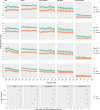Running trends in Switzerland from 1999 to 2019: An exploratory observational study
- PMID: 39820153
- PMCID: PMC11737753
- DOI: 10.1371/journal.pone.0311268
Running trends in Switzerland from 1999 to 2019: An exploratory observational study
Abstract
Background: Several single race events (5 km, 10 km, half-marathon, marathon, ultra-marathon) in different countries and different years have been analyzed in multiple studies, representing the rising interest in endurance-based activity and thus physical health. With focus on participation numbers, performance or sex difference, many single study results were obtained. The running trends in a whole country covering a longer period of time and several race distances are missing so far.
Objectives: The aim of this study is therefore to examine 5 km, 10 km, half-marathon, marathon and ultra-marathon races by age, sex, participation numbers and performance during two decades (1999-2019) for one country (Switzerland).
Methods: In this exploratory observational study, we analyzed 1,172,836 finishers (370,517 women and 802,319 men) competing between 1999 and 2019 in 5 different race distances in Switzerland. We used publicly available data about the athletes and examined total finishing numbers, sex, age and performances (measured in m/s) via descriptive analyses and linear mixed models. Do-not-finishers were excluded.
Results: The most frequented race was the half-marathon (33.1% of finishers), the less frequented was the ultra-marathon distance (8.5% of finishers). In most recent years, only the number of finishers in ultra-marathon, especially in trail runs increased. In total, there were more male finishers (68.4%) than female finishers (31.6%) and only in 5 km races, more women finished than men (55.3%). Men were faster than women and both sexes were running slower in all race distances across years. Athletes in 10 km races had the best performance within the five analyzed race distances. Median age increased with longer race distance and decreased in ultra-marathon in recent years.
Conclusion: In summary, finishing numbers especially in ultra-marathons increased with a focus on trail runs, female and male athletes had a declining performance across years in all race distances and men ran faster than women. Median age increased with longer race distance leading to more aged endurance-trained athletes. A downtrend in median age is found only in ultra-marathon in recent years. The results are important for athletes, race directors and coaches with regard to training schedules and the trend towards long distance races as well as for the medical attendance especially of older athletes, being more and more interested in endurance running.
Copyright: © 2025 Witthöft et al. This is an open access article distributed under the terms of the Creative Commons Attribution License, which permits unrestricted use, distribution, and reproduction in any medium, provided the original author and source are credited.
Conflict of interest statement
The authors have declared that no competing interests exist.
Figures










Similar articles
-
Change in elevation predicts 100 km ultra marathon performance.Sci Rep. 2025 Jul 11;15(1):25176. doi: 10.1038/s41598-025-09502-0. Sci Rep. 2025. PMID: 40646069 Free PMC article.
-
Glycaemic Effects of a 156-km Ultra-trail Race in Athletes: An Observational Field Study.Sports Med. 2024 Aug;54(8):2169-2184. doi: 10.1007/s40279-024-02013-4. Epub 2024 Mar 30. Sports Med. 2024. PMID: 38555307
-
Influence of Sex, Athletic Category and Athletic Level on Marathon Pacing Strategy: An Analysis of the Trinidad Alfonso EDP Valencia Marathon From 2014 to 2023.Eur J Sport Sci. 2025 Jul;25(7):e12329. doi: 10.1002/ejsc.12329. Eur J Sport Sci. 2025. PMID: 40531717 Free PMC article.
-
A rapid and systematic review of the clinical effectiveness and cost-effectiveness of paclitaxel, docetaxel, gemcitabine and vinorelbine in non-small-cell lung cancer.Health Technol Assess. 2001;5(32):1-195. doi: 10.3310/hta5320. Health Technol Assess. 2001. PMID: 12065068
-
Systemic pharmacological treatments for chronic plaque psoriasis: a network meta-analysis.Cochrane Database Syst Rev. 2021 Apr 19;4(4):CD011535. doi: 10.1002/14651858.CD011535.pub4. Cochrane Database Syst Rev. 2021. Update in: Cochrane Database Syst Rev. 2022 May 23;5:CD011535. doi: 10.1002/14651858.CD011535.pub5. PMID: 33871055 Free PMC article. Updated.
References
-
- Abbas A. The embodiment of class, gender and age through leisure: A realist analysis of long distance running. Leis Stud. 2004;23(2).
Publication types
MeSH terms
LinkOut - more resources
Full Text Sources
Miscellaneous

